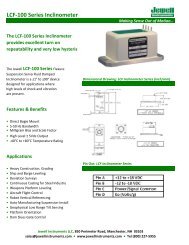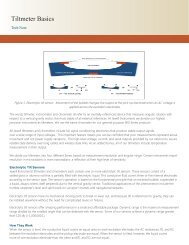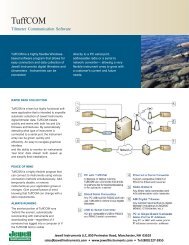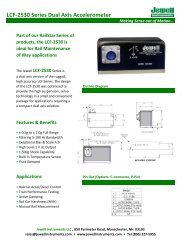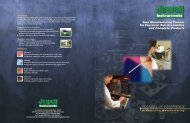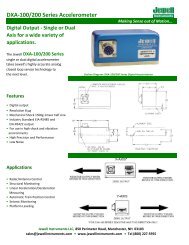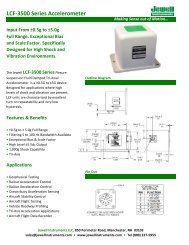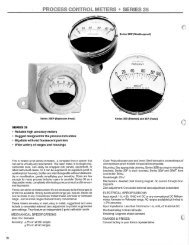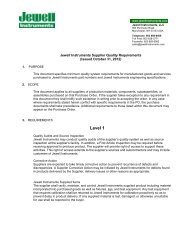Sensors Catalog - Jewell Instruments
Sensors Catalog - Jewell Instruments
Sensors Catalog - Jewell Instruments
You also want an ePaper? Increase the reach of your titles
YUMPU automatically turns print PDFs into web optimized ePapers that Google loves.
Accelerometers<br />
All <strong>Jewell</strong> accelerometers are fully self-contained. They connect to a DC power source and a readout or control device<br />
for a complete operating system. The output is a high-level DC signal proportional to acceleration and tilt angle sine<br />
from as little as ± 0.010 g to ±20 g full range. <strong>Jewell</strong> accelerometers respond to change in velocity as small as 1µg.<br />
Hysteresis less than 0.0005% of full range output and vibration rectification less than 50 µG/G 2 are available.<br />
LCM Series<br />
A general purpose tilt sensor for industrial, commercial, and<br />
aerospace applications. Engineered with micromachined<br />
components, the LCM offers an attractive price/performance<br />
ratio. This 0.5g to 5g device meets the demanding needs of<br />
applications requiring 500g shock resistance and up to<br />
500Hz bandwidth.<br />
LSM Series<br />
The LSM Series offers features equivalent to the LCA,<br />
but in a smaller package, approximately 1” cube. Its<br />
smaller size and wide bandwidth and range make it ideal<br />
for many aerospace applications.<br />
LCA Series<br />
A 0.5g to 5g full scale acceleration sensing device with pivot<br />
and jewel suspension technology and 60Hz-250Hz bandwidth<br />
make the LCA-100 popular for a variety of military,<br />
commercial, and aerospace sensing applications.<br />
LCF Series<br />
The most rugged of all our accelerometers, the LCF-200<br />
is a compact, highly accurate, high-performance sensor<br />
with a range of 0.50g to 5g full scale; ideal for many<br />
military and rugged commercial uses. Internal electronics<br />
options feature single-ended self-test and a 2-pole output<br />
noise suppression filter.<br />
LCF-200 LCA-100 LSM LCM-100<br />
Performance<br />
Input Range, g: ±0.5 ±2.0 ±5.0 ±0.5 ±2.0 ±5.0 ±0.5 ±1.0 ±2.0 ±5.0 ±10.0 ±20.0 ±0.5 ±2.0 ±5.0<br />
Full Range Output (FRO), volts ±1% 1 : ±5.0 ±5.0 ±5.0 ±5.0 ±5.0 ±5.0 ±5.0 ±5.0 ±5.0 ±5.0 ±5.0 ±5.0 ±5.0 ±5.0 ±5.0<br />
Nonlinearity, % FRO 2 : 0.05 0.05 0.05 0.05 0.05 0.05 0.05 0.05 0.05 0.10 0.10 0.25 0.20 0.20 0.20<br />
Scale Factor, volts/g, nominal: 10.0 2.50 1.00 10.0 2.50 1.00 10.0 5.0 2.5 1.0 0.5 0.25 10.0 2.5 1.0<br />
Scale Factor Temp Sens, PPM/°C max: 100 100 100 180 180 180 200 200 200 200 200 200 0.50% reading over the temp. range<br />
Bias, g, maximum: 0.005 0.005 0.005 0.01 0.01 0.01 0.050 0.010 0.010 0.010 0.020 0.050 0.05 0.10 0.10<br />
Bias Temperature Sensitivity, µg/°C, max: 50 50 50 .100 100 100 50 50 50 100 100 200 003g/°C .003g/°C .003g/°C<br />
Natural Frequency, Hz, nominal 3 : 30 30 30 60 60 60 70 100 140 100 140 160 60 60 60<br />
Bandwidth (-3db), Hz, nominal: 30 30 30 60 60 60 70 100 140 100 140 160 60 60 60<br />
Transverse Axis Misalignment, °max: 1.0 1.0 1.0 1.0 1.0 1.0 1 1 1 1 1 1 3.0 3.0 3.0<br />
Resolution and Threshold, µg max: 10 10 10 100 100 100 10 10 10 10 20 50 0.005g 0.005g 0.005g<br />
Electrical<br />
Input Voltage, VDC: ±12 to ±18 ±12 to ±18 ±12 to ±18 ±12 to ±18<br />
Input Current, mA, nominal: 15 25 10 15<br />
Output Impedance, ohms, nominal: 100 100 10.0k 5.0k 2.5k 5.0k 2.5k 2.5k 100<br />
Noise, Vrms, maximum: 0.002 0.005 0.005 0.020 0.010 0.010<br />
Environmental<br />
Operating Temp Range: -40°C to +80°C -55°C to +85°C -55°C to +85°C -40°C to +85°C<br />
Survival Temp Range: -60°C to +90°C -65°C to +90°C -65°C to 105°C -65°C to +85°C<br />
Shock: 1000g, 1msec,1/2 sine 100g, 11msec, 1/2 sine 100g, 11msec, 1/2 sine 500g, 0.5msec,1/2 sine<br />
Vibration: 20 grms 5 grms 5 grms 10 grms<br />
Seal: Epoxy Epoxy Epoxy Epoxy<br />
Weight: 5oz. 4oz. 2 oz. 4 oz.<br />
1. Full Range is defined “from negative full input acceleration to positive full input acceleration.”<br />
2. Nonlinearity is specified as deviation of output referenced to theoretical input function value,<br />
independent of misalignment.<br />
3.<br />
Output Phase angle = -90°.<br />
3



